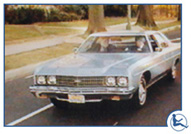|
|
 |
AIRBAGS THAT KILL OR INJURE
 Airbags have proven to be wonderful life-savers, throughout their implementation in our cars and other vehicles that began in the late-1980's.
Yet, some particular airbag systems have unfortunately caused severe to fatal injuries to small children, and to shorter drivers who sit rather close to the steering wheel, especially in low-speed collisions where the same person would likely have survived with minimal injuries. As of 2000, some airbag systems have killed around 100 children and 60 short-stature adults, plus many others with severe injuries caused by poorly-designed driver and passenger airbags. Airbags have proven to be wonderful life-savers, throughout their implementation in our cars and other vehicles that began in the late-1980's.
Yet, some particular airbag systems have unfortunately caused severe to fatal injuries to small children, and to shorter drivers who sit rather close to the steering wheel, especially in low-speed collisions where the same person would likely have survived with minimal injuries. As of 2000, some airbag systems have killed around 100 children and 60 short-stature adults, plus many others with severe injuries caused by poorly-designed driver and passenger airbags.
Here's an overview of some of the basic defects that may apply to various airbag systems, making some needlessly too lethal to particular occupants in specific crashes.
- Crash Sensors That Trigger at Too Low a Crash Speed.
The more lethal designs have crash sensors that needlessly trigger in minor low-speed crashes of only 7 to 15 miles per hour, while safer designs trigger in crashes above 15 or 18 mph. Minimalistic crash sensors, which may be mounted on brackets attached to the radiator shroud near the car's headlights, can sometimes generate a false signal that a more significant crash is occurring, or can delay the signal, so that the airbag either inflates needlessly or too late in the crash event.
- Horizontal Inflation Path.
Some airbags inflate horizontally from the front face of the instrument panel directly at the head of a small child, while safer designs are mounted atop the instrument panel and initially inflate vertically upward.
- Overly-Powerful Inflators.
Some airbags systems have a "one size fits all" design with extremely forceful airbag inflation. Safer multi-force inflators were feasible all these years, and are now being implemented in many newer airbag systems. In addition, there are techniques to inflate the airbag sequentially in stages, or via multi-chamber designs, rather than in a single high-pressure burst.
-
 Lack of Internal Tethers. Lack of Internal Tethers.
The use of internal tether straps causes the airbag to inflate into a flatter pillow shape that's also further from the driver or passenger, rather than a large rounded basketball shape that is potentially more injurious.
- Failure to Crash Test with Range of Dummies.
Too many automakers failed to crash-test their prototype and production airbags systems with a range of dummies that represent infants, small children, short-stature females, and large adult males, to make sure the airbag would protect and also not cause injuries to drivers and passengers of various sizes.
 About 11,000 GM cars in the 1973-76 era did in fact have airbags (as a $235 option) for the driver and front seat passengers, and they've performed extremely well in actual accidents over the years. The 1973 Chevrolet Impala sedan shown here was one of GM's original fleet of airbag production cars... all of which were equipped in 1973 with airbags for the driver and both front passengers. The passenger airbag inflated "softer" in crashes from 12-to-18 MPH, and inflated "firmer" in crashes above 18 MPH, in order to reduce the airbag inflation hazard to small children who might be on the front seat. About 11,000 GM cars in the 1973-76 era did in fact have airbags (as a $235 option) for the driver and front seat passengers, and they've performed extremely well in actual accidents over the years. The 1973 Chevrolet Impala sedan shown here was one of GM's original fleet of airbag production cars... all of which were equipped in 1973 with airbags for the driver and both front passengers. The passenger airbag inflated "softer" in crashes from 12-to-18 MPH, and inflated "firmer" in crashes above 18 MPH, in order to reduce the airbag inflation hazard to small children who might be on the front seat.
 Think of all the lives that could have been saved, and all the severe injuries prevented, if the American auto industry and foreign automakers had continued with airbag implementation... continuing what had been constructively demonstrated with those 11,000 airbag-equipped GM cars in the 1973-1976 era, many of which had been in collision accidents and had performed superbly to save lives. Think of all the lives that could have been saved, and all the severe injuries prevented, if the American auto industry and foreign automakers had continued with airbag implementation... continuing what had been constructively demonstrated with those 11,000 airbag-equipped GM cars in the 1973-1976 era, many of which had been in collision accidents and had performed superbly to save lives.
|